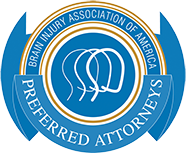Truck Driver Fatigue Accidents
As many as 15 million big rigs transport almost three-quarters of America’s freight on our roads. Trucking is a demanding and exhausting job. With tight schedules, long hours, and irregular sleep patterns, it’s no wonder that truck driver fatigue is behind so many wrecks.

When you’ve been seriously injured or worse in an accident due to trucker fatigue, it’s absolutely imperative that you speak to an experienced truck accident attorney right away. While trucking is not an easy job, drowsy driving is negligence. You could be entitled to significant compensation for your injuries.
Read on to learn more about the seriousness of driver fatigue in truckers, the rest break rules they are bound by, and what you can do if you’ve been injured because of such a collision.
The Virginia truck accident attorneys at The Smith Law Center are available at any time to give free, private legal consultations for truck accident victims. Simply contact us at (757) 244-7000.

Trucker Fatigue Crash Statistics
Truck driver fatigue continues to be a main cause behind preventable commercial vehicle accidents.
In a study by the Federal Motor Carrier Safety Administration (FMSCA), researchers collected information on over 120,000 commercial truck accidents during the course of three years. They considered the causes behind 249 deaths and 1,654 injuries.
The study found that 13% of drivers were sleep-deprived at the time of their crash. It also revealed that driver fatigue, speeding, and alcohol consumption were three of the top overall factors in the crashes.





The National Transportation Safety Board believes the real number of trucker fatigue related crashes is underrepresented in fatality reports, and up to 40% of crashes involve truck driver fatigue.

About Smith Law Center
However, a previous study by the National Transportation Safety Board suggests that the actual number of accidents due to trucker fatigue is actually much higher. They believe the “incidence of driver fatigue is underrepresented” in the Fatal Accident Reporting System (FARS). Instead, they estimate that as many as 30-40 percent of trucking crashes are caused by driver fatigue.
In 2018, this number would translate to 1,448 lives in a single year for large truck crashes alone, which accounted for 4,136 deaths (Insurance Institute for Highway Safety).
Let’s take a closer look at the most common factors that lead to trucker fatigue.
Causes of Trucker Fatigue
It’s true that truckers are up against the odds when it comes to ensuring they’re properly rested before getting behind the wheel. In fact, normal working conditions for truckers put them at a greater risk for poor health compared to the average working adult, as a survey by the Centers for Disease Control showed.
For one, truck driving is a sedentary job, limiting the driver’s physical movement for hours on end. Due to routes in remote areas, truckers also have limited access to healthier foods in order to maintain a proper diet. While these factors don’t directly result in driver fatigue, they certainly contribute to it.

Below are a few of the most common work and health conditions associated with truck driver fatigue.
Long Hours
Truckers’ hours are determined by the FMSCA’s Hours of Service (HOS) regulations. Although these rules are meant to safeguard the drivers and other motorists, they allow a trucker to drive for hours at a time. Trucking companies often violate these rules and pressure their drivers to meet impossible deadlines.
We cover more on this in the next section about trucker rest break rules and regulations.
Diabetes
Fluctuating insulin levels from diabetes can cause severe tiredness, even a loss of consciousness behind the wheel. This was such a concern that the FMCSA previously prohibited diabetic drivers from driving big rigs, until they updated their guidelines in 2018. Now, diabetics are required to submit medical documents proving their insulin levels are stable enough for driving long hours.
Debate continues about whether these updated guidelines are enough to address the complications associated with diabetes.
Unrealistic Expectations
On top of imposing long hours, many trucking companies also face driver shortages. As an attempt to remedy this while still meeting quotas, companies might offer driver incentives that encourage faster, increased driving time.
These policies don’t explicitly violate regulations, though they create unrealistic expectations. Compensating truckers in this way rewards them for overexerting themselves and perpetuates this cycle.
Sleep Apnea

Drivers with untreated sleep apnea are also linked to crashes. Obstructive sleep apnea is a disorder that blocks breathing airways during sleep, leaving a person fatigued even after sufficient rest.
Sleep apnea is a serious, potentially life-threatening condition, particularly because it often goes unrecognized and undiagnosed. Federal regulations forbid drivers with conditions like sleep apnea to operate commercial motor vehicles without treatment. Yet, the frightening reality is that many truckers still do, putting themselves and others at risk for devastating consequences.
Trucking regulations have attempted to minimize the amount of tired truckers on the road, though there is still a question about whether or not the rules actually work. We discuss the key ones in the next section.
Truck Driver Fatigue Rules & Regulations
The Federal Motor Vehicle Carrier Safety Administration has Hours of Service (HOS) regulations that apply to truckers across the country. While these rules were created in response to the driver fatigue problem, they are regularly challenged by trucking companies. Safety campaigners continue to question whether they adequately address the issue.
Below are the regulations truckers must abide by:
The 11-Hour Driving Limit
A commercial vehicle driver may drive a maximum of 11 hours after ten consecutive hours off-duty. The 11-hour clock only ticks while the truck is being driven.
The 14-Hour Driving Limit
A trucker may not drive beyond the 14th consecutive hour after ten consecutive hours off-duty. Off-duty time does not extend the trucker’s 14-hour period. The clock does not stop even when a driver switches to off-duty or sleeper berth mode. Once the 14-hour period is up, the driver must take a ten-hour break before driving again.

Rules Relating to Trucker Rest Breaks
A commercial vehicle driver may get back on the road only if eight hours or less have passed since the end of their last sleeper berth or off-duty period of at least 30 minutes. There are exceptions for short-haul drivers.
This means before eight hours are up, a trucker must take at least a 30-minute rest break in sleeper or off-duty status. After that, the driver has — at maximum — another eight hours to work before he or she is required to take a 30-minute break again.
The 34-Hour Restart Rule
The 34-hour restart rule describes a rule where truckers may restart a consecutive seven or eight-day period after they take 34 or more consecutive hours off-duty. Truckers are not to drive after 60 hours within seven days or 70 hours within eight consecutive days.
The HOS rules consistently top the list of concerns cited by the trucking industry. However, many safety campaigners say these rules don’t go far enough.
These rules are understandably complex and most crash victims are unaware of them. When you hire the right truck accident attorney, you won’t have to worry about trying to perform your own investigation into these matters. Not only will your lawyer handle this, but he or she will use this and more evidence to prove your entitlement to compensation.
When Truckers Falsify Log Books
As with rest break regulations, truckers are also required to keep track of their hours of service (HOS) with logbooks. A truck driver logbook is a record of their driving time and activity. Truckers used to manually fill these out on carbon paper sheets, making it much easier to fudge their hours and rest times.
But in 2017, congress sought to change that by passing the Electronic Logging Device (ELD) Mandate, which required that commercial vehicles install automated monitoring systems. These replaced the manual logbooks with a goal to improve HOS accuracy and thus, road safety by reporting violations.
Still, because drivers are often paid according to their logbooks, they still have reason to falsify their information and lie about taking breaks. Unfortunately, it isn’t uncommon for drivers and the companies they work for to conspire in falsifying their logbooks.
As mentioned before, trucking companies have been known to place unrealistic expectations on drivers, paying them for stretching their hours or meeting crammed schedules. Both the driver and trucking company can be held liable for forgery if they have manipulated or finagled a driver log.
On top of this, there are still several small trucking fleets who have not yet implemented ELDs in their trucks. This means drivers are still manually reporting their HOS, leaving room for fatigued drivers to fly under the radar and endanger our roads.
Whether on an ELD or manual logbook, truckers are still doing this. When they’re caught, unfortunately, it’s often too late.
Can you sue if you were hit by a fatigued truck driver?
Yes, you can.
The frightening reality is that drowsy driving is just as dangerous as drunk driving. And, similar to drunk driving, it’s also preventable.
There are a number of reasons why a trucker may have been driving without enough sleep, as we’ve seen. However, if a collision occurs due to an error on the tired trucker’s part, a lawsuit will most likely find him or her at fault.
If you’ve been injured in such a crash, it is highly recommended that you speak with a seasoned truck accident attorney. At The Smith Law Center, we’ve helped countless families come to terms with the types of catastrophic injuries that result from such accidents.
The main issue behind crashes from truck driver fatigue is negligence. If the crash could have been prevented and you were injured, the negligent person may be held liable. Your attorney will seek to obtain rightful compensation for your family if the trucker’s negligence is established.
Injuries From Accidents Due to Truck Driver Fatigue
Why is trucker fatigue such a concern on our roads? The short answer is that a fatigued driver behind the wheel of a 40-ton truck can do astounding damage, and, unfortunately they often do. Tired truckers are as dangerous as an unmanned commercial airplane when they get behind the wheel.
This makes the injuries life-altering. Both truckers and drivers/passengers in the vehicles they hit suffer, but those in cars or passenger vehicles suffer disproportionately more.
Common injuries from these crashes are:
- Spinal cord injury
- Internal bleeding
- Paraplegia or quadriplegia
- Broken bones
- Traumatic Brain Injury (TBI)
- Wrongful death
These injuries are severe. As such, they will require costly medical treatment and often lifelong rehabilitation. The expenses begin accumulating immediately following a crash, which is why it’s in your family’s best interest to contact a lawyer as soon as possible.
How can filing a lawsuit help?

Getting the help of a qualified truck accident attorney can make all the difference in your healing process. The right attorney will have a proven track record of resolving cases like yours and will know what to look for when determining how much compensation you are owed.
Financial compensation can make the recovery process significantly better for you and your family, covering costs such as:
- Medical bills
- Lifelong treatment and rehabilitation
- Reconstructive surgery
- Home or vehicle accommodations
- Childcare
- Trauma counseling
- Loss of consortium
The sooner you get the help of a legal advocate, the better your chances will be for obtaining the full amount of compensation you are entitled to.
Don’t wait; give yourself and your loved ones the best chances at making a strong recovery. Get in touch with an attorney to learn about your options.
Tired truckers are as dangerous as an unmanned commercial airplane when they get behind the wheel.
Contact a Truck Accident Lawyer
Trucking companies will often do all in their power in an attempt to protect themselves from paying out a large sum of money. This is why it’s critical to entrust the details of your case to an experienced attorney.
The Smith Law Center has brought multiple multi-million dollar trucking cases to verdict, including a $10.2 million verdict, believed to be the largest trucking wreck verdict in Norfolk, Virginia. We understand that no amount of financial compensation can change the past, though we assure you that we will do all we can to return you and your family to a sense of normalcy.
Please contact us today to learn how we can help you and your loved ones during this trying time. Call us now for a free, private consultation at (757) 244-7000.





